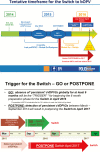Implementing the Synchronized Global Switch from Trivalent to Bivalent Oral Polio Vaccines-Lessons Learned From the Global Perspective
- PMID: 28838179
- PMCID: PMC5854099
- DOI: 10.1093/infdis/jiw626
Implementing the Synchronized Global Switch from Trivalent to Bivalent Oral Polio Vaccines-Lessons Learned From the Global Perspective
Abstract
In 2015, the Global Commission for the Certification of Polio Eradication certified the eradication of type 2 wild poliovirus, 1 of 3 wild poliovirus serotypes causing paralytic polio since the beginning of recorded history. This milestone was one of the key criteria prompting the Global Polio Eradication Initiative to begin withdrawal of oral polio vaccines (OPV), beginning with the type 2 component (OPV2), through a globally synchronized initiative in April and May 2016 that called for all OPV using countries and territories to simultaneously switch from use of trivalent OPV (tOPV; containing types 1, 2, and 3 poliovirus) to bivalent OPV (bOPV; containing types 1 and 3 poliovirus), thus withdrawing OPV2. Before the switch, immunization programs globally had been using approximately 2 billion tOPV doses per year to immunize hundreds of millions of children. Thus, the globally synchronized withdrawal of tOPV was an unprecedented achievement in immunization and was part of a crucial strategy for containment of polioviruses. Successful implementation of the switch called for intense global coordination during 2015-2016 on an unprecedented scale among global public health technical agencies and donors, vaccine manufacturers, regulatory agencies, World Health Organization (WHO) and United Nations Children's Fund (UNICEF) regional offices, and national governments. Priority activities included cessation of tOPV production and shipment, national inventories of tOPV, detailed forecasting of tOPV needs, bOPV licensing, scaling up of bOPV production and procurement, developing national operational switch plans, securing funding, establishing oversight and implementation committees and teams, training logisticians and health workers, fostering advocacy and communications, establishing monitoring and validation structures, and implementing waste management strategies. The WHO received confirmation that, by mid May 2016, all 155 countries and territories that had used OPV in 2015 had successfully withdrawn OPV2 by ceasing use of tOPV in their national immunization programs. This article provides an overview of the global efforts and challenges in successfully implementing this unprecedented global initiative, including (1) coordination and tracking of key global planning milestones, (2) guidance facilitating development of country specific plans, (3) challenges for planning and implementing the switch at the global level, and (4) best practices and lessons learned in meeting aggressive switch timelines. Lessons from this monumental public health achievement by countries and partners will likely be drawn upon when bOPV is withdrawn after polio eradication but also could be relevant for other global health initiatives with similarly complex mandates and accelerated timelines.
Keywords: IPV; OPV; Polio; endgame; eradication; inactivated polio vaccine; oral polio vaccine; poliovirus.
© The Author 2017. Published by Oxford University Press for the Infectious Diseases Society of America.
Figures


References
-
- Global Polio Eradication Initiative, World Health Organization, Geneva, Switzerland. http://www.polioeradication.org/Dataandmonitoring/Poliothisweek.aspx. Accessed 15 February 2017.
-
- Global Polio Eradication Initiative, World Health Organization, Geneva, Switzerland. http://www.polioeradication.org/mediaroom/newsstories/Global-eradication.... Accessed 15 February 2017.
-
- Global Polio Eradication Initiative. Polio Eradication and Endgame Strategic Plan 2013–2018. WHO/POLIO/13.02 http://www.polioeradication.org/Portals/0/Document/Resources/StrategyWor... Accessed 24 August 2016.
-
- Patel M, Orenstein W. A world free of polio–the final steps. N Engl J Med 2016; 374:501–3. - PubMed
Publication types
MeSH terms
Substances
Grants and funding
LinkOut - more resources
Full Text Sources
Other Literature Sources
Medical
Miscellaneous

